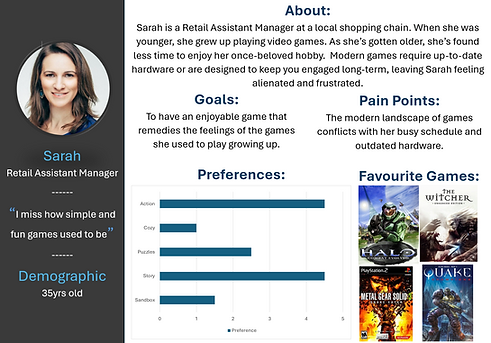Planning
Preparation
To assist with development decisions made during production, 2 UX personas were put together, Seen in Figures 1 and 2. Personas are fictional characters that represent traits or qualities within users and act as an important tool for understanding a target audience (Bruton, 2022). In this case, the personas are designed towards casual and core gamers, each with their specifications surrounding their wants from video games. Highlighting the planned design elements of progressions and simplicity, helping with decision-making surrounding them and targeting an outlined demographic.


Figure 1 - UX Persona 1
Figure 2 - UX Persona 2
Initially, a Trello board was used to track development progress and outline epics and user stories, as it has always been a personal choice for overviewing tasks in past projects. However, part way through development the realisation was made that Trello has a plethora of issues that conflicted with the heavier enthesis on planning and grander scale of this project. Alongside this, many of Trellos useful features are locked behind a pay-wall, making them inaccessible. Alternatively, Clickup provides an incredibly succinct workflow management system. It allows for multiple boards under one project, helping with separating the larger development stages and allowing room to delve further into detail of each requirement. Subtasks are also provided, a feature that is personally helpful which is absent from Trello, and allows for further breakdown of more lightweight requirements in the form of story’s (Rehkopf, 2024), such as breaking down the audio UI interactions into button presses and typing sound effects. Despite this discovery coming about 3 weeks into development, it felt imperative to switch over to ClickUp, especially since it allows transferring data over from Trello. After the switch, a day was spent reorganising and delving further into the objects, leading to the board seen in Figure 3.
Figure 3 - "Design" section on Clickup Board

The plan
Speaking of prioritization, the goal is to develop the minimum viable product as early as possible, as past projects have shown that due to an abundance of tutorials and resources online, an MVP can be developed quickly. Whilst there is space to iterate on ideas, the project will follow a more rigid waterfall workflow, planning from the beginning and focusing on that goal to the end of development (Adobe Communications, 2022). This workflow works for the project as there is a clear plan throughout on each step of development with every intended feature, especially among the 3 implementation stages of prototype, level design and visual and audio overall. The downside is the limited time, with a workflow that heavily relies on the completion of every step before moving on, falling behind on schedule could result in many important features planned later in development, such as visuals, being either rushed or completely left out. To remedy this, the 3 main stages mentioned earlier were outlined. If development falls behind on a stage of development, features will be scaled back and considerably more focus will be put towards the fundamental and important features of that stage. Whilst this may result in the loss of smaller details and additions, it'll ensure a more streamlined development and maintain structure to guarantee a more complete product.
During the development of a previous major project, burnout and stress were large issues faced. It’s important to keep mental and physical health in check and avoid letting development on this project consume every thought throughout the day. Burnout can cause procrastination or worsen the quality of the project (Vermani, 2024). Whilst development isn't planned down to the days, an exception is made for Tuesday, which will serve as a break day. Despite the break, sketching, concept art, and mood boards are still permitted as they already act as personal forms of catharsis and stress relief. Thought that exception is subject to review if it turns out to impact breaks and lead to potential burnout.
As for primary research and feedback, two rounds of playtesting will be conducted. The first one will be after the completion of the level design. After which, play testers will take a form that prompts them about the various aspects of the game and level design, as online forms can be a fast and inexpensive way to conduct user feedback (Gaille, 2020). A second playtest will be conducted after the visual and audio overhaul, which will prompt play testers on the same questions as the first form alongside further questioning about the visuals and audio. Repeating questions between forms will allow further review of changes made due to feedback on the first form and allow continued refinement of features. A potential issue is the continuity of respondents between the first and second forms, as vastly different opinions on questions may provide conflicting feedback and statistics. Questioning players on whether they had taken the previous feedback form could further narrow down respondents' results in case of large contradictions in responses.